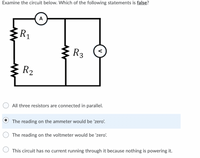Question

Transcribed Image Text:Examine the circuit below. Which of the following statements is false?
A
R1
:R3
R2
All three resistors are connected in parallel.
The reading on the ammeter would be 'zero'.
The reading on the voltmeter would be 'zero'.
This circuit has no current running through it because nothing is powering it.
Expert Solution
This question has been solved!
Explore an expertly crafted, step-by-step solution for a thorough understanding of key concepts.
Step by stepSolved in 2 steps

Knowledge Booster
Similar questions
- Part A What is the internal resistance of a 12.0-V car battery whose terminal voltage drops to 9.3 V when the starter motor draws 84 A ? Express your answer to two significant figures and include the appropriate units. HẢ ? r = Value Units Submit Request Answer Part B What is the resistance of the starter? Express your answer to two significant figures and include the appropriate units. HÀ ? R = Value Unitsarrow_forwardYour car's 31.8-W headlight and 2.50-kW starter are ordinarily connected in parallel in a 12.0-V system. What power would one headlight and the starter consume if connected in series to a 12.0-V battery? (Neglect any other resistor in the circuit and any change in resistance in the two devices. Give your answer to at least one decimal place.) Warrow_forwardWhen unequal resistors are connected in parallel in a circuit, a the same current always runs through each resistor. b the potential drop is always the same across each resistor. c the largest resistance has the largest current through it. d the power generated in each resistor is the same.arrow_forward
- Consider a circuit consisting of a battery and two bulbs. Explain why the following two statements are direct consequences of the preceding definitions. A. When two bulbs are connected in series, the same current that passes through one bulb must also pass through the other. B. When two bulbs are connected in parallel, current that passes through one bulb does not pass through the other.arrow_forwardThe circuit shown has two resistors, with R1 > R2 .Which resistor dissipates the larger amount of power? Explain.arrow_forwardIn the circuit below, if R5 is replaced by a resistor that is a third of R5, which one of the following statement about the currents in each branch is correct? R4 in RS O The only thing that will change is the current flowing through R5. O Changing R5 does not affect the currents in the circuit. O The only thing that will change is 1. O Current 11 will change, as well as currents flowing through R2, R3 and R5. O Currents flowing in R3 and in R2 will change but 11 will remain constant.arrow_forward
arrow_back_ios
arrow_forward_ios